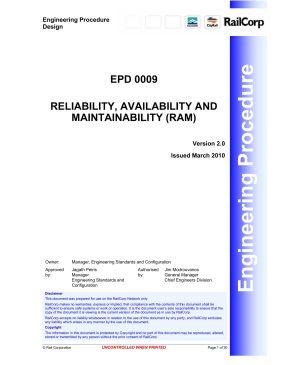RAMS is a characteristic of a system’s long term operation and is achieved by the application of established engineering concepts, methods, tools and techniques throughout the lifecycle of the system. The RAMS of a system can be characterised as a qualitative and quantitative indicator of the degree that the system, or the sub-systems and components comprising that system, can be relied upon to function as specified and to be both available and safe.
Defines standard
Replaced/Superseded by document(s)
Cancelled by
Amended by
| File | MIME type | Size (KB) | Language | Download | |
|---|---|---|---|---|---|
| Reliability, Availability and Maintainability.pdf | application/pdf | 137.23 KB | English | DOWNLOAD! |
Provides definitions
Introduction
This procedure applies to the management of reliability, availability and maintainability (RAM) of the railway system. RAM is a subset of RAMS which also includes safety. Safety management in design is addressed in procedure EPD 0008. The goal of the railway system is to achieve a defined level of rail traffic in a given time, safely. RAMS of the rail system describes the confidence with which the system can guarantee the achievement of this goal. It influences the ‘quality of service’ being delivered to the customer. Quality of service is also influenced by other attributes concerning functionality and performance such as the frequency of service, life cycle costs and fare structures.

